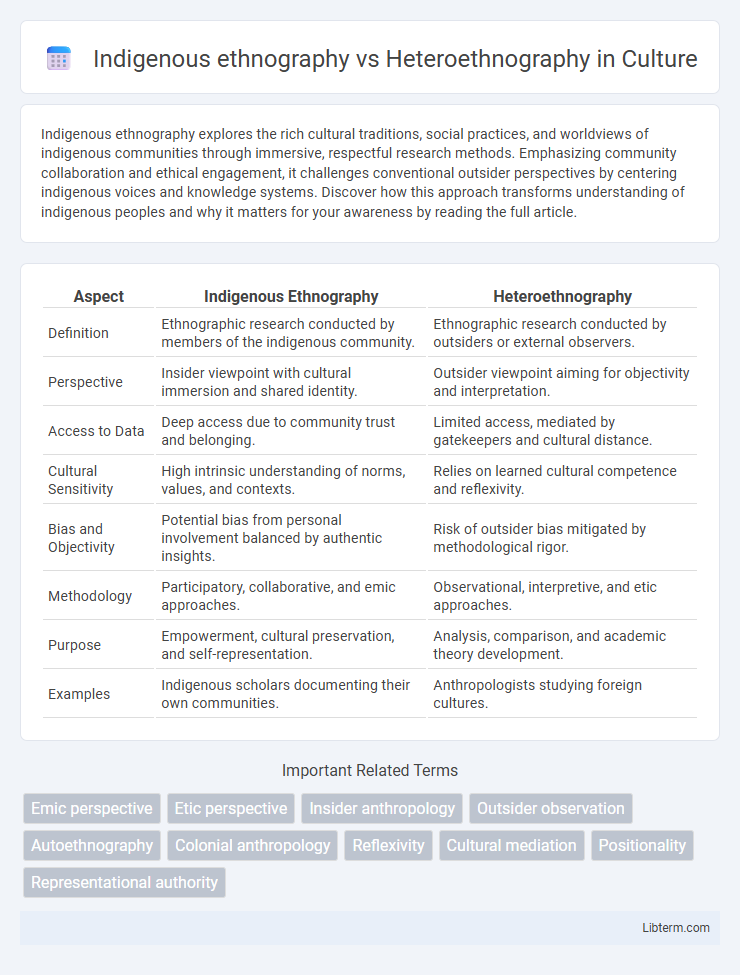Indigenous ethnography explores the rich cultural traditions, social practices, and worldviews of indigenous communities through immersive, respectful research methods. Emphasizing community collaboration and ethical engagement, it challenges conventional outsider perspectives by centering indigenous voices and knowledge systems. Discover how this approach transforms understanding of indigenous peoples and why it matters for your awareness by reading the full article.
Table of Comparison
| Aspect | Indigenous Ethnography | Heteroethnography |
|---|---|---|
| Definition | Ethnographic research conducted by members of the indigenous community. | Ethnographic research conducted by outsiders or external observers. |
| Perspective | Insider viewpoint with cultural immersion and shared identity. | Outsider viewpoint aiming for objectivity and interpretation. |
| Access to Data | Deep access due to community trust and belonging. | Limited access, mediated by gatekeepers and cultural distance. |
| Cultural Sensitivity | High intrinsic understanding of norms, values, and contexts. | Relies on learned cultural competence and reflexivity. |
| Bias and Objectivity | Potential bias from personal involvement balanced by authentic insights. | Risk of outsider bias mitigated by methodological rigor. |
| Methodology | Participatory, collaborative, and emic approaches. | Observational, interpretive, and etic approaches. |
| Purpose | Empowerment, cultural preservation, and self-representation. | Analysis, comparison, and academic theory development. |
| Examples | Indigenous scholars documenting their own communities. | Anthropologists studying foreign cultures. |
Defining Indigenous Ethnography
Indigenous ethnography centers on research conducted by Indigenous peoples about their own cultures, emphasizing self-representation and community collaboration to preserve authenticity. It challenges traditional heteroethnography, which often involves outsider perspectives that may misinterpret or appropriate Indigenous knowledge. Rooted in decolonizing methodologies, Indigenous ethnography prioritizes Indigenous epistemologies, protocols, and sovereignty within ethnographic practice.
Understanding Heteroethnography
Understanding heteroethnography involves analyzing cultures from an outsider's perspective, emphasizing the interpretative frameworks imposed by external researchers. Unlike Indigenous ethnography, which centers on insider knowledge and lived experiences of native communities, heteroethnography often reflects power dynamics influencing representation and authenticity in ethnographic research. Critical examination of heteroethnographic methods reveals challenges in achieving genuine cultural insight due to potential biases and contextual misunderstandings.
Historical Contexts and Paradigms
Indigenous ethnography centers Indigenous peoples' perspectives, emphasizing self-representation and countering colonial narratives that shaped traditional Western ethnographic methods. Heteroethnography often reflects outsider viewpoints, historically rooted in colonial paradigms that positioned Indigenous cultures as objects of study rather than active participants. Shifts toward decolonizing methodologies and collaborative research frameworks highlight the evolving paradigms responding to historical power imbalances in ethnographic practice.
Methodological Differences
Indigenous ethnography centers on research methods that prioritize Indigenous knowledge systems, community collaboration, and culturally sensitive approaches, contrasting with heteroethnography which often employs outsider perspectives and may impose external interpretive frameworks. Indigenous ethnographers emphasize relational accountability and ethical engagement, ensuring research respects Indigenous sovereignty and lived experiences, whereas heteroethnographic methods typically rely on observation and interpretation detached from Indigenous worldviews. Methodological differences highlight the importance of reflexivity, positionality, and power dynamics, with Indigenous ethnography promoting co-creation of knowledge and heteroethnography frequently maintaining hierarchical researcher-subject roles.
Insider vs Outsider Perspectives
Indigenous ethnography emphasizes insider perspectives, prioritizing the voices, knowledge systems, and lived experiences of Indigenous peoples themselves, fostering authenticity and cultural self-representation. Heteroethnography involves outsider researchers analyzing a culture from an external viewpoint, which may risk misinterpretation or bias without deep integration into the community. The contrast highlights the power dynamics inherent in ethnographic research and underscores the value of reflexivity and ethical engagement to ensure respectful and accurate cultural representation.
Ethics and Power Dynamics
Indigenous ethnography prioritizes research conducted by members of the community, emphasizing ethical accountability, cultural respect, and the empowerment of Indigenous voices to counter historical exploitation and misrepresentation. In contrast, heteroethnography, often performed by outsiders, risks perpetuating power imbalances by interpreting Indigenous lives through external perspectives, necessitating heightened ethical vigilance to avoid colonial biases and exploitative practices. The ethical framework in Indigenous ethnography centers on self-determination and collaborative knowledge production, challenging traditional power dynamics inherent in heteroethnographic methodologies.
Representation and Voice
Indigenous ethnography emphasizes authentic representation by centering Indigenous voices and perspectives, challenging traditional outsider narratives that often marginalize or misinterpret Indigenous experiences. Heteroethnography, practiced by non-Indigenous researchers, risks perpetuating power imbalances and cultural appropriation by interpreting Indigenous cultures through external frameworks. Ensuring Indigenous self-representation fosters ethical research practices and preserves cultural integrity within ethnographic studies.
Strengths and Limitations of Each Approach
Indigenous ethnography offers deep cultural insight and authentic perspectives by privileging voices from within the community, enhancing the validity of data through insider knowledge but may face challenges in maintaining objectivity. Heteroethnography benefits from an outsider's analytical distance, allowing comparative cultural analysis and broader theoretical frameworks, yet risks misinterpretation or superficial understanding due to cultural differences and potential biases. Both approaches contribute valuable methodologies to ethnographic research, with Indigenous ethnography emphasizing emic perspectives and Heteroethnography focusing on etic analysis.
Case Studies in Indigenous and Heteroethnography
Case studies in Indigenous ethnography emphasize native perspectives, prioritizing community voices and cultural continuity to produce nuanced, insider knowledge critical for decolonizing research methodologies. In contrast, heteroethnography examines Indigenous cultures from an outsider's standpoint, often risking misinterpretation or reinforcement of stereotypes due to limited cultural immersion and empathy. Comparing both approaches highlights the importance of methodological reflexivity and ethical engagement in ethnographic research to accurately represent Indigenous experiences and sociocultural dynamics.
Future Directions and Collaborative Possibilities
Indigenous ethnography prioritizes community-led narratives and ethical frameworks that respect Indigenous knowledge systems, fostering decolonized research methodologies. Future directions emphasize collaborative approaches that empower Indigenous voices by integrating digital storytelling and participatory action research. Heteroethnography, often conducted by outside researchers, can enhance cross-cultural understanding through partnerships that promote mutual respect and shared authority in knowledge production.
Indigenous ethnography Infographic

 libterm.com
libterm.com